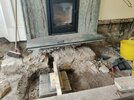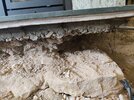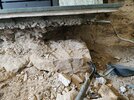- Joined
- 23 Nov 2017
- Messages
- 32
- Reaction score
- 1
- Country

The foundation under the hearth seems to be (in this order from bottom up):
1. Earth
2. Large sandstone blocks
3. Loose rubble
4. Concrete/rubble mixed
5. Cement
6. Granite hearth
We want to tile the hearth so I'm leaning towards removing it all and rebuilding. I had thought about supporting it under the cement with a joist but perhaps simpler to rebuild it.
Wondering what's the best way to rebuild it and end up with a level hearth?
1. Earth
2. Large sandstone blocks
3. Loose rubble
4. Concrete/rubble mixed
5. Cement
6. Granite hearth
We want to tile the hearth so I'm leaning towards removing it all and rebuilding. I had thought about supporting it under the cement with a joist but perhaps simpler to rebuild it.
Wondering what's the best way to rebuild it and end up with a level hearth?



